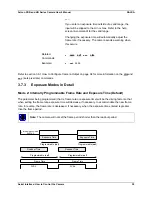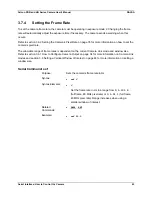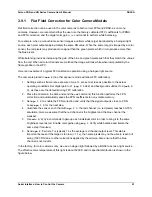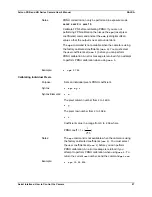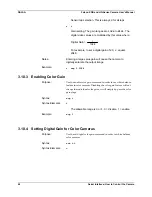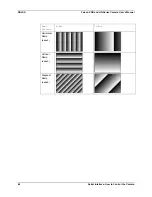
Falcon XDR and HG Series Camera User's Manual
DALSA
Serial Interface: How to Control the Camera
49
PRNU correction requires a clean, white reference. The quality of this reference is important for proper
calibration. White paper is often not sufficient because the grain in the white paper will distort the
correction. White plastic or white ceramic will lead to better balancing. Alternatively, if you slightly defocus
the camera you can effectively remove any grain and still achieve good PRNU correction.
Note:
If your illumination or white reference does not extend the full field of view of the
camera, the camera will send a warning.
For best results, ensure that:
1. 60 Hz ambient light flicker is sufficiently low not to affect camera performance and calibration
results.
2. The brightest pixel should be slightly below the target output. If the target is too close, then some
pixels may not be able to reach their full swing (1023 DN dynamic range) due to the correction
applied by the camera.
3. The camera will give a warning when 1% of pixels in the frame are at the maximum coefficient
value. When a pixel is at the maximum coefficient value, it means the pixel could not be properly
corrected. When 6.25% of pixels from a single row within the region of interest are clipped, flat
field correction results may be inaccurate.
4. Correction results are valid only for the current analog offset values.
Flat Field Calibration Example Procedure
The following is a flat field calibration example, using serial commands:
1. The camera is placed in
sem 2
.
2. Settings such as frame rate, exposure time, and so forth, are set as close as possible to actual
operating conditions. Set the digital gain to 1 x gain (
ssg 0 1024
) and background subtract to 0
(
ssb 0 0
) as these are the defaults during FFC calibration. In addition, ensure that you are in
non-concurrent operation. In non-concurrent mode, readout and integration do not overlap, thus
eliminating some residual artifacts associated with concurrent operation.
3. Place the camera in the dark and send the
ccf
command. This performs the FPN correction and
automatically saves the FPN coefficients to non-volatile memory.
4. Set
epc 1 0
, which enables the FPN correction and verify the signal output is close to 0 DN.
Leave
epc 1 0
for the next step since the
cpa
target assumes there is no FPN.
5. Illuminate the sensor, such that with
epc 1 0
, it reaches 50%-70% saturation.
6. Send
cpa 2 T
where T is typically 1.3 x the average output level. This is important since if the
target it too low (< 1.1 x ), then some pixels may not be able to reach full swing (1023 DN) due to
corrections applied by the camera.
7. If satisfied by the results write the FPN coefficients and PRNU coefficients to memory (
wfc
and
wpc
).
Содержание Falcon 1.4M100 HG Monochrome
Страница 18: ...DALSA Falcon XDR and HG Series Camera User s Manual 18 Introduction to the Falcon XDR and HG Cameras ...
Страница 28: ...DALSA Falcon XDR and HG Series Camera User s Manual 28 Camera Hardware Interface ...
Страница 70: ...DALSA Falcon XDR and HG Series Camera User s Manual 70 Optical and Mechanical Considerations ...
Страница 74: ...DALSA Falcon XDR and HG Series Camera User s Manual 74 Troubleshooting ...
Страница 90: ...DALSA Falcon XDR and HG Series Camera User s Manual 90 Appendix C EMC Declaration ...
Страница 92: ...DALSA Falcon XDR and HG Series Camera User s Manual 92 Technical Support ...
Страница 95: ...Falcon XDR and HG Series Camera User s Manual DALSA Index 95 serial interface 72 V video data 76 ...





